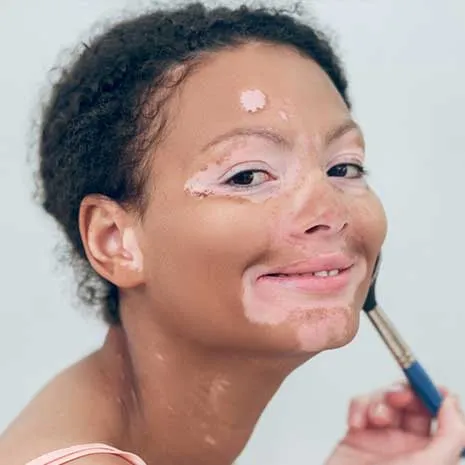How to Conceal Vitiligo with Makeup: Professional Techniques and Product Tips

How to Conceal Vitiligo with Makeup: Professional Techniques and Product Tips
- 22 August 2025
- 428

Can Vitiligo Patches Be Covered with Makeup?
Vitiligo is a condition characterized by the loss of melanin, resulting in white patches on the skin. These patches are more noticeable on sun-exposed areas such as the face, neck, and hands.
Makeup can serve as a powerful tool for cosmetic camouflage, helping people with vitiligo feel more comfortable and confident in their appearance. However, since vitiligo skin can be sensitive, the choice of products and techniques is crucial.
When Should Makeup for Vitiligo Be Used?
Makeup is a temporary and non-therapeutic solution. It’s especially useful in:
- Social events and weddings
- Professional meetings or interviews
- Public speaking or media appearances
- Blending uneven skin tone after phototherapy or treatment
Prepping the Skin Before Makeup Application
Proper skin preparation ensures that makeup adheres well and looks natural throughout the day.
1. Gentle Cleansing
Use a mild, fragrance-free cleanser to clean the skin and remove oils and dirt.
2. Moisturizing
Hydration is key. Use moisturizers with ingredients like aloe vera, hyaluronic acid, or ceramides for smoother makeup application.
3. Sun Protection
Vitiligo skin lacks melanin and is more vulnerable to UV damage. Use a broad-spectrum sunscreen, ideally tinted, to protect and even out tone.
Best Makeup Products for Covering Vitiligo
Covering white patches requires high-pigment, long-wear makeup products. Some are specifically designed for vitiligo and other skin conditions.
1. Color Correctors
Use based on the undertone of the patch:
- For pink or red undertones: Green corrector
- For white patches: Yellow or beige corrector to neutralize contrast
2. Full-Coverage Foundations
Opt for high-pigment cream foundations that match your natural skin tone. Trusted brands include Dermablend, Kryolan, and Coverderm.
3. Concealer Sticks or Creams
For extra coverage in specific areas. Choose waterproof, non-comedogenic formulas.
4. Setting Powder or Spray
Use a translucent setting powder or a fixing spray to ensure long-lasting results.
Step-by-Step: How to Apply Makeup to Cover Vitiligo
Step 1: Cleanse and Moisturize
Start with clean and well-hydrated skin.
Step 2: Apply Color Corrector
Gently dab a color corrector on the vitiligo patches using your fingertips or a sponge. Blend well.
Step 3: Apply Foundation
Use a stippling brush or beauty sponge to apply full-coverage foundation in tapping motions, avoiding rubbing.
Step 4: Spot Conceal
Apply additional concealer on areas that need extra coverage, especially around the edges of patches.
Step 5: Set the Makeup
Finish with setting powder or a fixing spray to lock in coverage and improve durability.
Recommended Brands and Products
Here are dermatologist-tested options for effective vitiligo coverage:
- Dermablend Leg and Body Cover – Great for arms, legs, and larger body areas
- Vichy Dermablend Foundation – Suitable for everyday facial use
- Cover FX Custom Cover Drops – Add pigmentation to moisturizers or foundations
- Kryolan Dermacolor Camouflage Crème – Theatre-grade coverage for resistant patches
Waterproof and Sweat-Resistant Makeup Tips
To ensure your makeup lasts through heat, sweat, or water exposure:
- Use waterproof formulas specifically designed for long wear
- Apply thin, pigmented layers instead of overloading with multiple products
- Start with a primer and end with a setting spray
- Avoid touching or wiping treated areas while wet
Makeup Alternatives for Men with Vitiligo
Men may prefer subtler options like:
- Tinted sunscreens
- BB creams
- Camouflage sticks
These offer minimal coverage while maintaining a natural look, especially useful for those uncomfortable with traditional makeup routines.
Important Considerations for Vitiligo Skin
- Ingredients Matter: Choose fragrance-free, alcohol-free, and paraben-free products
- Tool Hygiene: Clean brushes and sponges regularly
- Patch Test: Always test new products on a small skin area
- Nightly Removal: Never sleep with makeup on—use gentle removers
- Avoid Irritants: Do not apply on broken or inflamed skin
Psychological Benefits of Makeup Use
While makeup does not treat vitiligo, it can significantly enhance self-esteem. Being able to control how your skin looks offers a sense of agency and comfort, especially in social or professional settings.
Frequently Asked Questions
Yes, with the right high-coverage products and techniques, complete coverage is achievable.
Not if you use gentle, non-irritating, and hypoallergenic products. Always consult a dermatologist.
It’s safe for daily use if you follow proper cleansing and skin care routines.
Absolutely. There are low-profile and natural-looking products tailored for men.
No, but avoid applying makeup during active topical treatment or immediately after phototherapy sessions unless advised by your doctor.
